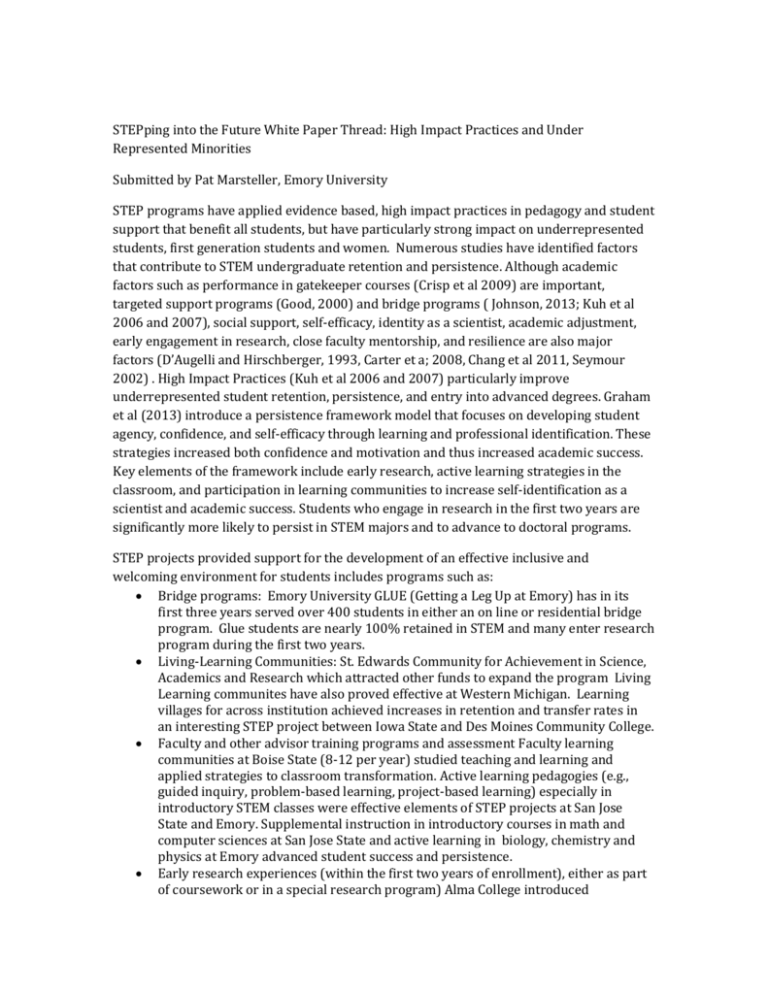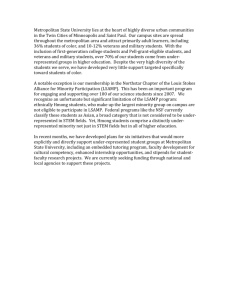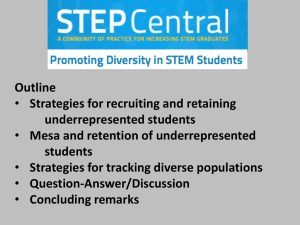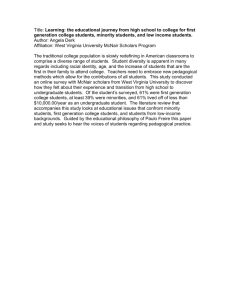STEPping into the Future White Paper Thread: High Impact Practices
advertisement

STEPping into the Future White Paper Thread: High Impact Practices and Under Represented Minorities Submitted by Pat Marsteller, Emory University STEP programs have applied evidence based, high impact practices in pedagogy and student support that benefit all students, but have particularly strong impact on underrepresented students, first generation students and women. Numerous studies have identified factors that contribute to STEM undergraduate retention and persistence. Although academic factors such as performance in gatekeeper courses (Crisp et al 2009) are important, targeted support programs (Good, 2000) and bridge programs ( Johnson, 2013; Kuh et al 2006 and 2007), social support, self-efficacy, identity as a scientist, academic adjustment, early engagement in research, close faculty mentorship, and resilience are also major factors (D’Augelli and Hirschberger, 1993, Carter et a; 2008, Chang et al 2011, Seymour 2002) . High Impact Practices (Kuh et al 2006 and 2007) particularly improve underrepresented student retention, persistence, and entry into advanced degrees. Graham et al (2013) introduce a persistence framework model that focuses on developing student agency, confidence, and self-efficacy through learning and professional identification. These strategies increased both confidence and motivation and thus increased academic success. Key elements of the framework include early research, active learning strategies in the classroom, and participation in learning communities to increase self-identification as a scientist and academic success. Students who engage in research in the first two years are significantly more likely to persist in STEM majors and to advance to doctoral programs. STEP projects provided support for the development of an effective inclusive and welcoming environment for students includes programs such as: Bridge programs: Emory University GLUE (Getting a Leg Up at Emory) has in its first three years served over 400 students in either an on line or residential bridge program. Glue students are nearly 100% retained in STEM and many enter research program during the first two years. Living-Learning Communities: St. Edwards Community for Achievement in Science, Academics and Research which attracted other funds to expand the program Living Learning communites have also proved effective at Western Michigan. Learning villages for across institution achieved increases in retention and transfer rates in an interesting STEP project between Iowa State and Des Moines Community College. Faculty and other advisor training programs and assessment Faculty learning communities at Boise State (8-12 per year) studied teaching and learning and applied strategies to classroom transformation. Active learning pedagogies (e.g., guided inquiry, problem-based learning, project-based learning) especially in introductory STEM classes were effective elements of STEP projects at San Jose State and Emory. Supplemental instruction in introductory courses in math and computer sciences at San Jose State and active learning in biology, chemistry and physics at Emory advanced student success and persistence. Early research experiences (within the first two years of enrollment), either as part of coursework or in a special research program) Alma College introduced undergraduate research and first year seminars, increasing their undergraduate STEM interest in research by 56%! This route that has proven effectivenss for many institutions including Emory, which expanded its long term summer and academic year research programs to fist and second year students in part with STEP funding. Tarleton State and Temple College instituted early research and paid special emphasis to transfer students. Over 150 students participated in summer research. Northern Kentucky achieved a 50% increase in BS degrees in part due to early research experiences for those at risk of leaving STEM fields. References Crisp, G., Nora, Al, & Taggart, A. (2009). Student characteristics, pre-college, and environmental factors as predictors of majoring in and earning a STEM degree: An analysis of students attending a Hispanic Serving Institution. AmericanEducational Research Journal, 46(4), 924-942. Good, J.M., A Promising Prospect for Minority Retention: Students Becoming Peer Mentors. Journal of Negro Education, 2000. 69(4): p. 375-83. Jeffe, D. B., Andriole, Dorothy A., Wathington, Heather D., Tai, Robert H. Educational Outcomes for MD-PhD Program Matriculants: A National Cohort Study. Acad Med. 2014 89(1): 1-16. DOI: 10.1097/ACM 0000000000000071 Johnson, Lakitta. The Benefits of a Comprehensive Retention Program for African American Students at a Predominantly White University. Interdisciplinary Journal of Teaching & Learning. Spring 2013, Vol 3(1) :38-52 Kuh, George D., Jillian Kinzie, Ty Cruce, Rick Shoup and Robert M. Gonyea Connecting the Dots: Multi-Faceted Analysis of the Relationships between Student Engagement Results from the NSSE, and the Institutional Practices and Conditions that Foster Student Success. 2006, Lumina Report. Kuh GD, Kinzie J, Cruce T, Shoup R, Gonyea RM. 2007. Connecting the Dots: MultiFaceted Analyses of the Relationships between Student Engagement Results from the NSSE, and the Institutional Practices and Conditions That Foster Student Success, NSSE, http://nsse.iub.edu/pdf/Connecting_the_Dots_Report.pdf Carter, Frances D., Mandell, Marvin, and Maton, Kenneth I. The Influence of ON-Campus, Academic Year Undergraduate Research on STEM Ph.D. Outcomes: Evidence from the Meyerhoff Scholarship Program. Educational Evaluation and Policy Analysis. American Educational Research Association and Sage Publications. Dec 2009 31(4): 441 DOI: 10.3102/0162373709348584 Version of Record Dec 2009. http://epa.sagepub.com/content/31/4/441 Chang, Mitchell J. Jessica Sharkness, Christopher B. Newman, and Sylvia Hurtado What Matters in College for Retaining Aspiring Scientists and Engineers 2011. AERA University of California Los Angeles D'Augelli, A.R. and S.L. Hershberger, African American Undergraduates on a Predominantly White Campus: Academic Factors, Social Networks, and Campus Climate. Journal of Negro Education, 1993. 62(1): p. 67-81. DeAngelo, L., Franke, R., Hurtado, S., Pryor, J. H., & Tran, S. (2011). Completing college: Assessing graduation rates at four-year institutions. Los Angeles: Higher Education Research Institute,UCLA. Seymour, E., Tracking the processes of change in US undergraduate education in science, mathematics, engineering, and technology. Science Education, 2002. 86(1): p. 79-105. Graham, Mark J, J. Frederick, Angela Byars-Winston and Jo Handelsman. Increasing Persistence of College Students in STEM. Science 27 September 2013: Vol. 341 no. 6153 pp. 1455-1456 DOI: 10.1126/science.1240487. http://www.sciencemag.org Chang, Mitchell J., Sharkness, Jessica, Hurtado, Sylvia, Newman, Christopher B. (2014) What Matters in College for Retaining Aspiring Scientists and Engineers from Underrepresented Racial Groups. Journal of Research in Science Teaching. Wiley Periodicals, Inc. pp 1:26 Higher Education Research Institute. (2010). Degrees of success: Bachelor’s degree completion rates among initial STEM majors. Los Angeles: Higher Education Research Institute. Moss-Racusin, Corinne Vander Toorn, jojanneke, Dovidin, John F., Brescoli, Victoria L., Graham, Mark J., Handelsman, Jo. Scientific Diversity Interventions. Policy Forum. Social Science 2014. 343: 6150616. Heep://www.sciencemag.org Nagda, Biren A., Gregerman, Sandra R., Jonides, John, VonHippel, William, and Lerner, Jeffifer. S. Undergraduate Student-Faculty Research Partnerships Affect Student Retention. ASHE: The Review of Higher Education 1998. 22(1): p 55-72. Seymour, E. and N.M. Hewitt, Talking About Leaving: Why Undergraduates Leave the Sciences. 1997: Westview Press pp444. http://books.google.com/books/about/Talking_about_leaving.html?id=e3h48xnglr UC Wilson, Zakiya, Holmes, Lakenya, deGravelles, Karin, Sylvain, Monica R., Batiste, Lisa, Johnson, Misty, McGuire, Sandra Y., Pang, Su Seng, Warner, Isaiah. Hierarchical Mentoring: A Transformative Strategy for Improving Diversity and Retention in Undergraduate STEM Disciplines. J Sci Educ Technol DOI 10.1007/s10956-0119292-5 Wisker G. 2005. The good supervisor: Supervising postgraduate and undergraduate research for doctoral theses and dissertations. pp. 388. http://books.google.com/books/about/The_good_supervisor.html?id=UnOqQgAA CAAJ: Palgrave Macmillan Woodard, D.B., S.L. Mallory, and A.M. De Luca, Retention and institutional effort: A selfstudy framework. NASPA Journal, 2001. 39(1): p. 53-83. Working Group on Diversity in the Biomedical Research Workforce (WGDBRW). 2012. Draft Report of the Advisory Committee to the Director Working Group on Diversity in the Biomedical Research Workforce. Zachary LJ. 2000. The Mentor's Guide: Facilitating Effective Learning Relationships. San Francisco: Jossey-Bass. 195 pp. Watson SS. 2003. Retaining Minority Students in Higher Education: A framework for success. ed. EP Institue. http://www.educationalpolicy.org/pdf/Retaining Minority Students.pdf Finley, Ashley, McNair, Tia. Assessing Underserved Students’ Engagement in High-Impact Practices. 2013. Association of American Colleges and Universities. LEAP. http://www.aacu.ort/assessinghips Villarejo M, Barlow AEL, Kogan D, Veazey BD, Sweeney JK. 2008. Encouraging Minority Undergraduates to Choose Science Careers: Career Paths Survey Results. CBE-Life Sciences Education 7: 394-409 Rath, Kenneth A., Peterfreund, Alan R. Xenos, Samuel P., Bayliss, Frank and Carnal, Nancy. Supplemental Instruction in Introductory Biology I: Enhancing the Performance and Retention of Underrepresented Minority Students. CBE Life Sci Educ, 2007. 6(3): p. 203-216. PCAST, President’s Council of Advisors on Science and Technology. Engage To Excel: Producing One Million Additional College Graduates with Degrees in Science, Technology, Engineering, and Mathematics. http://www.whitehouse.gov/sites/default/files/microsites/ostp/pcast-engage-toexcelfinal_2-25-12.pdf (accessed July 2013). National Science Foundation. National Center for Science and Engineering Statistics. Directorate for Social, Behavioral and Economic Sciences. Women, Minorities, and Persons with Disabilities in Science and Engineering: 2013. www.nsf.gov/statistics/wmpd/ National Research Council. 2011. Expanding Underrepresented Minority Participation: America’s Science and Technology Talent at the Crossroads. Wasjington, DC: The National Academies Press. Nagda, Biren A., Gregerman, Sandra R., Jonides, John, VonHippel, William, and Lerner, Jeffifer. S. Undergraduate Student-Faculty Research Partnerships Affect Student Retention. ASHE: The Review of Higher Education 1998. 22(1): p 55-72. Lewis, D., E., Sloan Guide for the successful recruitment of minority students into science and engineering PhD programs. 2003. http://www.nacme.org/user/docs/Sloan ManualFinallast _3_.pdf Hurtado, S., Milem, Jeffrey; Clayton-Pedersen, Alma; Allen, Walter., Enhancing Campus Climates for Racial/Ethnic Diversity: Educational Policy and Practice. Review of Higher Education, 1998. 21(3): p. 279-302. Graham, Mark J, J. Frederick, Angela Byars-Winston and Jo Handelsman. Increasing Persistence of College Students in STEM. Science 27 September 2013: Vol. 341 no. 6153 pp. 1455-1456 DOI: 10.1126/science.1240487. http://www.sciencemag.org American Association for the Advancement of Science. 2009. Understanding Interventions that Broaden Participation in Research Careers. In Conference on Understanding Interventions that Broaden Participation in Research Careers, ed. DE Chubin, AL DePass, L Blockus, pp. 153. Bethesda, MD American Association for the Advancement of Science. (2001). In pursuit of a diverse science, technology, engineering , and mathematics workforce: Recommended research priorities to enhance participation by underrepresented minorities. Washington, D.C.: AAAS. Hurtado, S., Eagan, Kevin, Sharkness, Jessica. Thinking and Acting Like a Scientist: Investigating the Outcomes of Introductory Science and Math Courses. 2009. http://www.heri.ucla.edu/PDFs/conference/AIR2009-ClassroomStudy.pdf: Hurtado, Sylvia, June C. Han, Victor B. Sa´enz, Lorelle L.Espinosa,Nolan L. Cabrera, and Oscar S. Cerna Predicting Transition and Adjustment to College: Biomedical and Behavioral Science Aspirants' and Minority Students' First Year of College. Research in Higher Education, 2007. 48(7): p. 841-887 Hunn, Vanessa. 2014. African American Students, Retention, and Team-Based Learning: A Review of the Literature and Recommendations for Retention at Predominately White Institutions. Journal of Black Studies published online 8 April 2014. DOI: 10.1177/0021934714529594 Hurtado,Sylvia, June C. Han, Victor B. Sa´enz, Lorelle L.Espinosa,Nolan L. Cabrera, and Oscar S. Cerna Predicting Transition and Adjustment to College: Biomedical and Behavioral Science Aspirants' and Minority Students' First Year of College. Research in Higher Education, 2007. 48(7): p. 841-887. Hurtado, S., Eagan, M. K., Cabrera, N. L., Lin, M. H., Park, J., & Lopez, M. (2008). Training future scientists: Predicting first-year minority student participation in health science research. Research in Higher Education, 49(2), 126-152.





